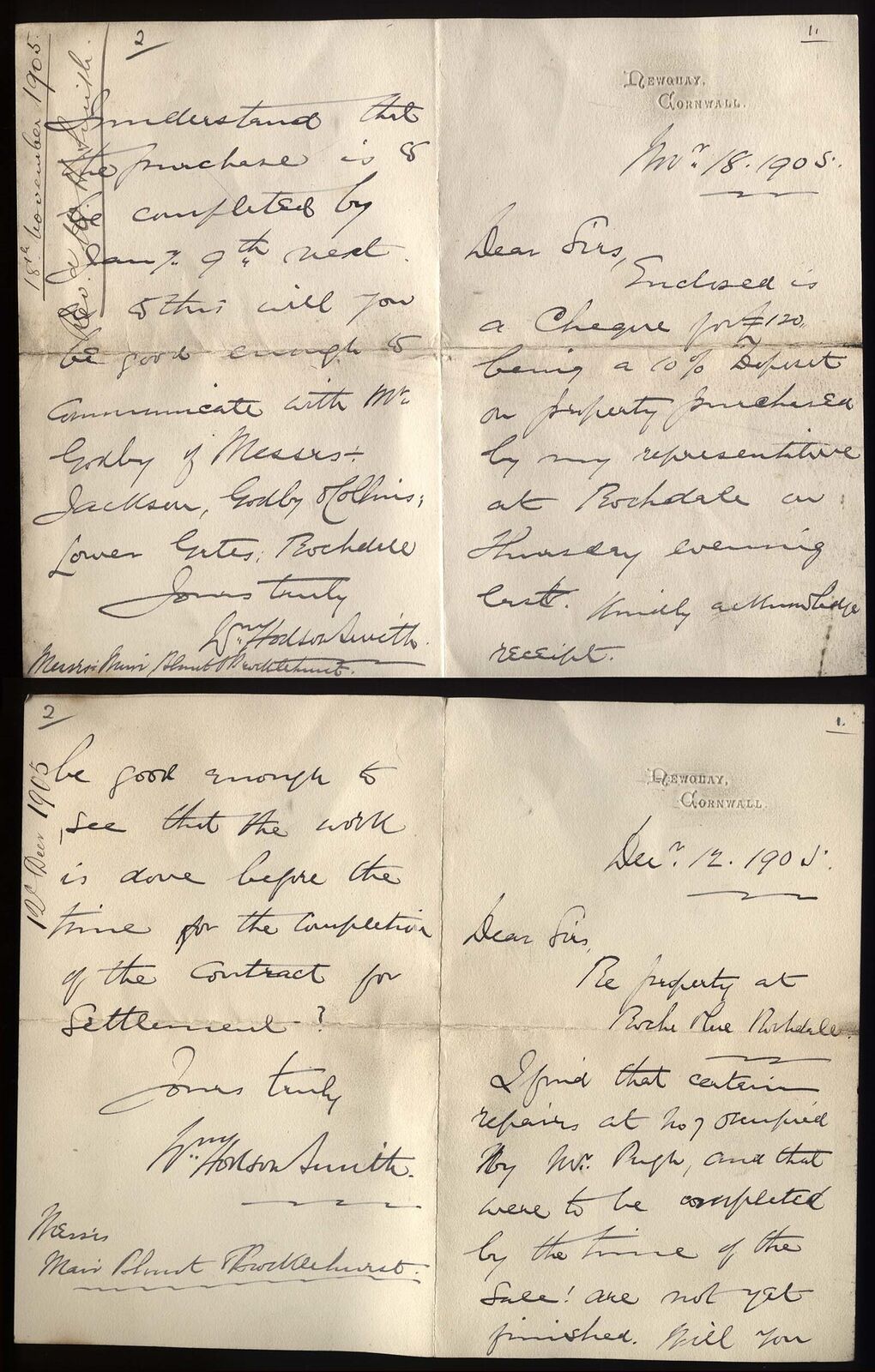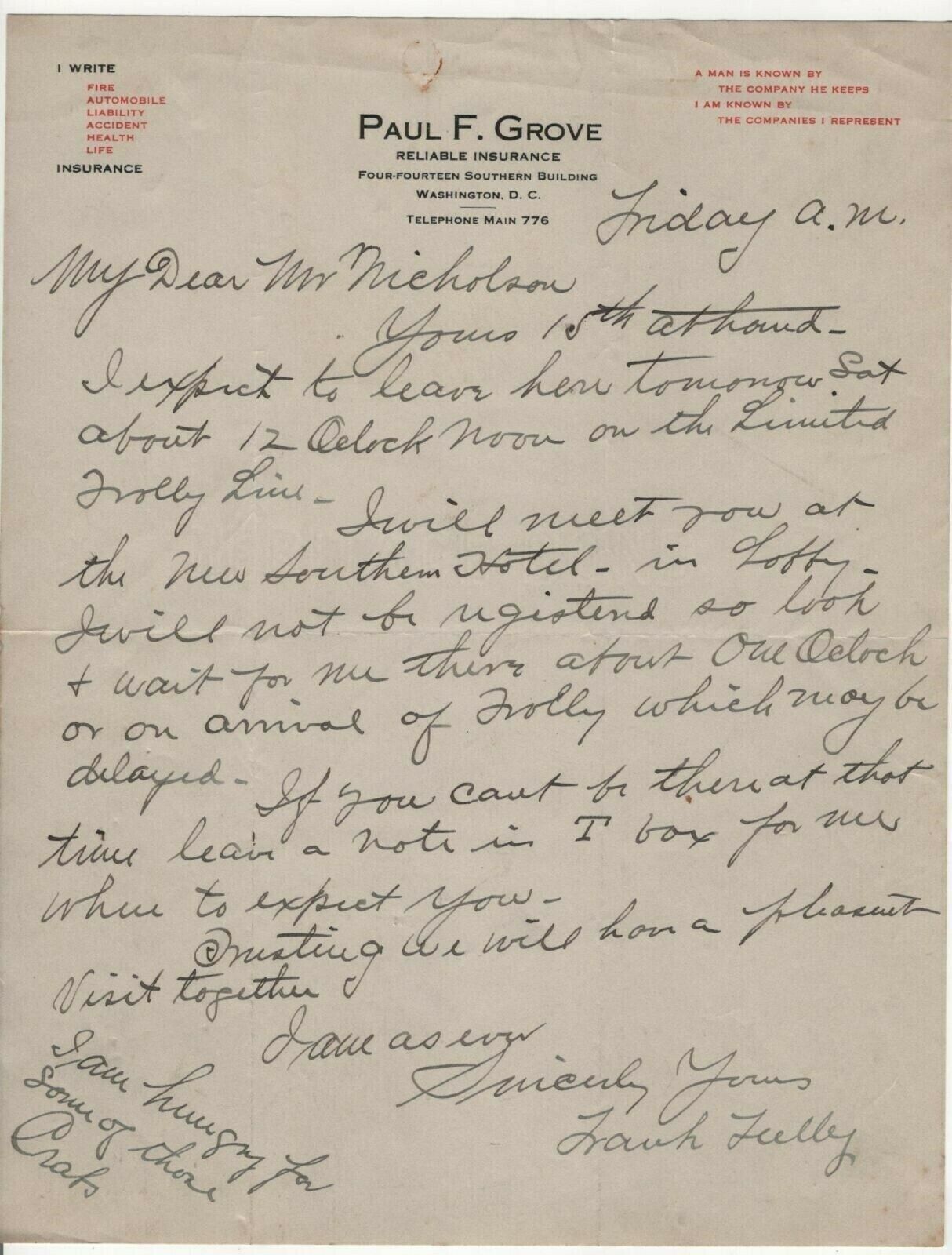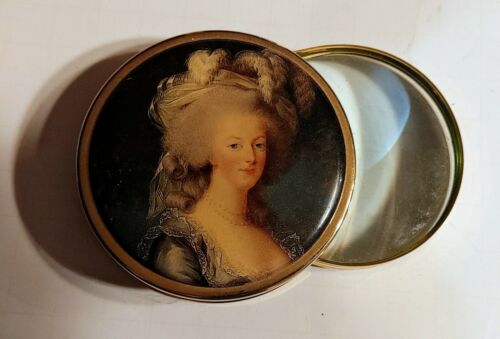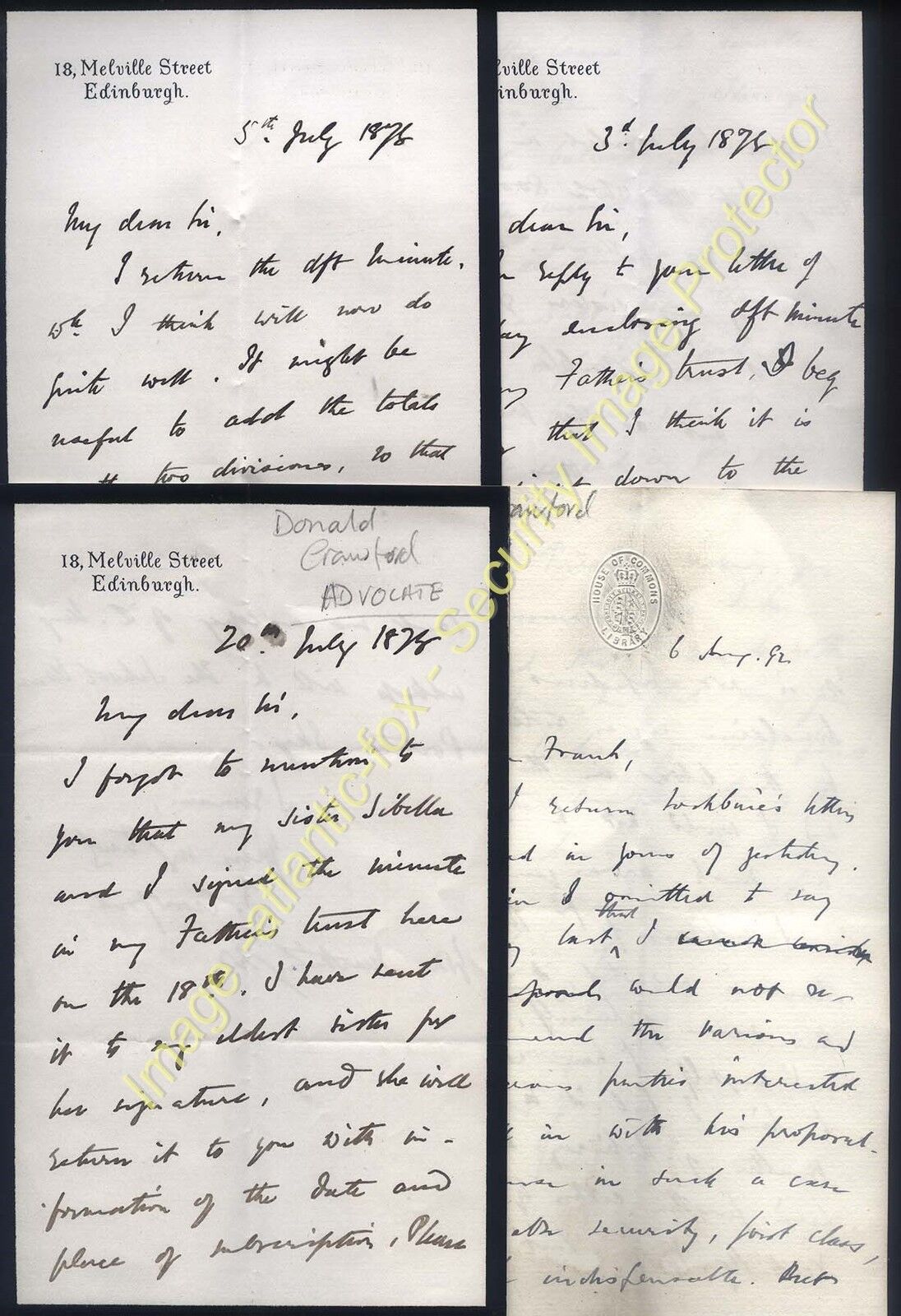-40%
1834 GORDON CASTLE, letter George Duncan GORDON, 5th Duke of GORDON to E Baillie
$ 54.38
- Description
- Size Guide
Description
1834 GORDON CASTLE, letter George Duncan GORDON, 5th Duke of GORDON to E BaillieThis product data sheet is originally written in English.
1834
GORDON
CASTLE, letter George Duncan Gordon, 5th Duke of Gordon to
Evan
Baillie
of
Dochfour
, Inverness. regarding a Colonel Ross who he is recommending as an Honourable Man
Gordon Castle
is located near
Fochabers
in Moray, Scotland. Historically known as the Bog-of-
Gight
or Bog
o'Gight
, it was the principal seat of the dukes of Gordon. Following 18th-century redevelopment, it became one of the largest country houses ever built in Scotland, although much has since been demolished.
General George Duncan Gordon, 5th Duke of Gordon,
GCB
, PC (2 February 1770 – 28 May 1836), styled Marquess of
Huntly
until 1827, was a British nobleman, soldier and politician and the last of his line
Early life
George was born at Edinburgh on 2 February 1770, the eldest son of Alexander Gordon, 4th Duke of Gordon and his wife, the celebrated Jane Gordon, Duchess of Gordon, née Lady Jane Maxwell. He was educated at Eton. He became a professional soldier and rose to the rank of general. As Marquess of
Huntly
, he served with the guards in Flanders from 1793 to 1794. He commanded the 92nd Highlanders, and commanded the regiment in Spain, Corsica, Ireland and the Netherlands from 1795 to 1799, where he was badly wounded. He commanded a division in the
Walcheren
Expedition of 1809.
He was a
freemason
and was Grand Master of the Grand Lodge of Scotland from 1792 to 1794. He was a member of Parliament for Eye from 1806 to 1807. On 11 April 1807, at the age of 37, he was summoned to the House of Lords in one of the minor peerages of his father (Baron Gordon of Huntley, co. Gloucester). He was appointed a Privy Counsellor in 1830, was Keeper of the Great Seal of Scotland from 1828 to 1830 (a post that his father had held until 1827), and from 1827 to 1836 was Governor of Edinburgh Castle.
He married at Bath, on 11 December 1813, Elizabeth Brodie, who was twenty-four years his junior. Brodie was the daughter of Alexander Brodie of Arnhall in Kincardineshire. Elizabeth Grant described her thus:
His bride was young and good, and rich, but neither clever nor handsome. She made him very happy and paid his most pressing debts, that is what her father did, old Mr. Brodie of the Burn, brother to Brodie of Brodie... Really to her husband her large fortune was the least part of her value; she possessed upright principles, good sense, and she turned out a first-rate woman of business. In her later years, she got into the cant of the Methodists.
However, at the time of his marriage and, in fact, until he inherited the Dukedom, George found himself in almost constant financial difficulties. He was referred to as "Lord Huntly now in the decline of his rackety life, overwhelmed with debts, sated with pleasure, tired of fashion, the last heir male of the Gordon line".[2] While his marriage remedied some of these problems, it did not supply the much sought-after heir.
Like his father, George acquired many of the positions which the Gordon family could expect almost as of right. These included the posts of Lord Lieutenant of Aberdeenshire, Chancellor of Marischal College, Aberdeen, and Lord High Constable of Scotland. He held the latter post of Lord High Constable for the coronation of King George IV in 1820.
By the time of his succession to the dukedom, he had established a reputation as an extreme reactionary. He steadfastly opposed the Great Reform Bill and when the majority of Tory Peers opted to abstain, he remained one of the twenty-two "Stalwarts" who voted against the Third Reading of the Bill in the House of Lords on 4 June 1832.
Throughout much of this period, his wife served Queen Adelaide at court. Indeed, she was given the Queen's coronation robe, which is now to be found with many other Gordon memorabilia at Brodie Castle.
Nathaniel Parker Willis, the American journalist, has left us with an interesting account of life at Gordon Castle in the twilight years of the 5th Duke's life. He described the "canonically fat porter" at the lodges who admitted him to a "rich private world peopled by ladies cantering sidesaddle on palfreys, ladies driving nowhere in particular in phaetons, gentlemen with guns, keepers with hounds and terrier at the heel, and everywhere a profusion of fallow deer, hares, and pheasants. At the castle a dozen lounging and powdered menials." Willis continued: "I never realised so forcibly the splendid results of wealth and primogeniture." Just before dinner, the Duke called at his room, "an affable white-haired gentleman of noble physiognomy, but singularly cordial address, wearing a broad red ribbon across his breast, and led him through files of servants to a dining room ablaze with gold plate."
Legacy
The Duke died at Belgrave Square, London, on 28 May 1836, aged 66. The Dukedom of Gordon became extinct, but the Marquessate of Huntly (created in 1599) passed to his distant cousin the Earl of Aboyne while the Gordon estates passed to his nephew, Charles Gordon-Lennox, 5th Duke of Richmond. The Gordon moveable property was left by the Duchess to the Brodies of Brodie.
Elizabeth Brodie, the last Duchess of Gordon, retired to Huntly Castle Lodge, where she became more fervently religious than she had previously been until her death on 31 January 1864, when the last trace of the original Dukedom of Gordon was also extinguished.
The Duke and Duchess of Gordon established the Gordon Chapel (Scottish Episcopal Church)[4] in Fochabers that contains a memorial tablet to the 5th and last Duke.
The Duke had three illegitimate children: Charles Gordon, Susan Sordet, and Georgiana McCrae.
Evan Baillie (1741 – 28 June 1835) was a Scottish slave-trader, merchant and landowner in the West Indies.[1] He was a Whig politician who sat in the House of Commons from 1802 to 1812.
Baillie was the third son of Hugh Baillie of Dochfour, Inverness and his wife Emilia Fraser, the daughter of Alexander Fraser.[2] Though it has been claimed that his early life was obscure and that he suffered "fatal neglect" in formal education,[3] it appears that he was educated in Inverness and that he remembered Simon Fraser, 11th Lord Lovat, visiting his mother to seek the support of the Baillies for the Jacobite cause and later witnessing the battle of Culloden from the hill above Dochfour. The Baillies remained loyal Hanovarians.[1] Evan entered the army in early life and served in part of the American war.
He was first in the West Indies in 1759–60, serving with the 4th Foot in Martinique, as his 1835 Inverness Courier obituary makes clear. Baillie himself seems to have been a staff officer to General William Howe at the Siege of Havana in the adjutant's department. He then transferred to the 19th Regiment (later the Green Howards) as a lieutenant, and retired on half-pay. He then seems to have spent most of the next 15 years in partnership with his brothers, Alexander and James, who had begun a partnership in St. Kitts known as Smith and Baillies, which was eventually based in Grenada and later in St. Vincent as the partnership of Garraway and Baillie. One of their business connections was with Henry Laurens of Charleston in South Carolina with whom they exchanged African slaves and plantation produce for necessary stores.[1] A 1779 letter from James Baillie to his cousin, William Baillie of Dunain, then serving in India,[4] indicates that Evan had returned to Britain in about 1774 and settled in Bristol. He became directly involved in the transport of slaves from Africa in 1784 when he funded the construction of the slave ship Emilia and in 1787 he also owned a share in the Daniel.
Alves also indicates that he was believed in 1775 to have married in the West Indies, marrying Mary Gurley of St Peter's Hope, St Vincent, in 1777. He founded what became the firm of Evan Baillie, Son & Co in Bristol, and was a common councilman for Bristol in 1785. He was sheriff of Bristol for 1786–87 but declined becoming mayor. In 1789 he was member of a committee of merchants to defend the slave trade, in all branches of which he had from time to time invested and financed.
During the French Revolutionary War he raised the Bristol Volunteer Infantry in 1797 and served as their Lieutenant-Colonel (Colonel in 1798). After the short-lived Peace of Amiens he re-raised them as the Royal Bristol Volunteer Infantry.
On the death of his brother Alexander in 1798 Baillie succeeded to the family estates in Inverness-shire. He was also partner in an Inverness hemp manufacturers and other businesses.[3] He continued to purchase more land in Scotland as a result of concerns about the effects of the war with France and effects of abolition of slavery.
In 1802 Baillie became an alderman of Bristol. Also in 1802, he was elected unopposed as Member of Parliament for Bristol.[9] He was unopposed again in 1806 and 1807. He noted how feeble were attempts in parliament to oppose slave trade abolition bill but he was not among those who made last stand against it. By 1811, he was suffering poor health and was concerned for his son Peter (by then MP for the Inverness burghs) who died in 1812. He therefore decided not to stand in the 1812 election.
Baillie retired to Scotland and left the business operations to his sons. He resigned as alderman of Bristol in 1821 pleading old age, but survived to the age of 94.[3] He was reputed to be one of the wealthiest commoners in Britain and his sons were among the largest recipients of compensation following emancipation.
His wife Mary Gurley was the daughter of Peter Gurley of St. Vincent.[2] Their sons Peter Baillie, Hugh Duncan Baillie and James Evan Baillie all became members of parliament. Baillie's brother James Baillie was also an MP and West Indies merchant.
:
Powered by SixBit's eCommerce Solution
1834 GORDON CASTLE, letter George Duncan Gordon, 5th Duke of Gordon to Evan Baillie of Dochfour, Inverness. regarding a Colonel Ross who he is recommending as an Honourable Man Gordon Castle is located near Fochabers in Moray, Scotland. Historically known as the Bog-of-Gight or Bog o'Gight, it was the principal seat of the dukes of Gordon. Following 18th-century redevelopment, it became one of the largest country houses ever built in Scotland, although much has since been demolished.General George Duncan Gordon, 5th Duke of Gordon, GCB, PC (2 February 1770 – 28 May 1836), styled Marquess of Huntly until 1827, was a British nobleman, soldier and politician and the last of his line Early lifeGeorge was born at Edinburgh on 2 February 1770, the eldest son of Alexander Gordon, 4th Duke of Gor
Type
Historical
Related Interests
Colonel Ross
EAN
Does Not apply
Country
Scotland
Estate or House name
Gordon Castle
Scotland County
Moray
Signed
Yes
Era
1830 - 1840
Addressed to
Evan Baillie
Year of Issue
1834
Document Type
Original Manuscript Letter
Written By
George Duncan Gordon
Titled Families
Duke of Gordon








